Residual Chlorella-Based Cellulose Nanofibers and Their Quaternization Modification and Efficient Anionic Dye Adsorption
Abstract
1. Introduction
2. Materials and Methods
2.1. Materials and Chemicals
2.2. Methods of Experiments
2.2.1. Preparation of CNF and CCNF
2.2.2. CNF Characterization
2.2.3. Calibration Curve Establishment for the Ultraviolet (UV) Absorption of CR with Varying Concentrations
2.2.4. Investigation on the Adsorption on CNF and CCNF of CR
3. Results and Discussion
3.1. Characterization of CNF and CCNF
3.2. Investigation on CR Adsorption on CNF and CCNF
3.2.1. Plotting of Calibration Curves
3.2.2. Study on the Adsorption Kinetics of CNF and CCNF
3.2.3. Effect of Initial Concentration of CR on the Adsorption Capacity of CNF and CCNF
3.2.4. Effect of pH Value of CR Solutions on the Adsorption Capacity of CNF and CCNF
3.2.5. Adsorption Isotherms
4. Conclusions
Author Contributions
Funding
Institutional Review Board Statement
Informed Consent Statement
Data Availability Statement
Conflicts of Interest
References
- Tian, H.; He, J. Cellulose as a scaffold for self-assembly: From basic research to real applications. Langmuir 2016, 32, 12269–12282. [Google Scholar] [CrossRef] [PubMed]
- Trache, D.; Hussin, M.H.; Chuin, C.T.H.; Sabar, S.; Fazita, M.R.N.; Taiwo, O.F.A.; Hassan, T.M.; Haafiz, M.K.M. Microcrystalline cellulose: Isolation, characterization and bio-composites application—A review. Int. J. Biol. Macromol. 2016, 93, 789–804. [Google Scholar] [CrossRef] [PubMed]
- Rejab, N.A.; Akindayo, J.O.; Mustapha, M. Crystallinity of nanocellulose and its application in polymer composites: A short review. Key Eng. Mater. 2022, 908, 74–79. [Google Scholar] [CrossRef]
- Jiang, X.; Mietner, J.B.; Harder, C.; Komban, R.; Chen, S.; Strelow, C.; Sazama, U.; Frba, M.; Gimmler, C.; Müller-Buschbaum, P. 3d printable hybrid gel made of polymer surface-modified cellulose nanofibrils prepared by surface-initiated controlled radical polymerization (si-set-lrp) and upconversion luminescent nanoparticles. ACS Appl. Mater. Interfaces 2023, 15, 5687–5700. [Google Scholar] [CrossRef]
- Hubbe, M.A.; Ana, F.; Preeti, T.; Yin, Y.; Carlos, S.; Lokendra, P.; Rojas, O.J. Nanocellulose in thin films, coatings, and plies for packaging applications: A review. Bioresources 2017, 12, 2143–2233. [Google Scholar] [CrossRef]
- Acharya, S.; De, S.; Nayak, G.C. Cnt/ldh-stabilized biomass-derived nanocellulose as a low-cost alternative for asymmetric supercapacitors: Impact of sources of nanocellulose. ACS Appl. Electron. Mater. 2023, 5, 406–417. [Google Scholar] [CrossRef]
- Joshi, R.; Sebat, N.; Chi, K.; Khan, M.; Johnson, K.I.; Alhamzani, A.G.; Habib, M.A.; Lindstrom, T.; Hsiao, B.S. Low fouling nanostructured cellulose membranes for ultrafiltration in wastewater treatment. Membranes 2023, 13, 147. [Google Scholar] [CrossRef]
- Busuioc, C.; Isopencu, G.O.; Deleanu, I.-M. Bacterial cellulose–polyvinyl alcohol based complex composites for controlled drug release. Appl. Sci. 2023, 13, 1015. [Google Scholar] [CrossRef]
- Abdullaevich, Y.S.; Ergashovich, Y.K.; Abdukhalilovich, S.A.; Sharkat O’G’Li, G.J. Synthesis and characterization of sodium-carboxymethylcellulose from cotton, powder, microcrystalline and nanocellulose. Polym. Eng. Sci. 2022, 62, 677–686. [Google Scholar] [CrossRef]
- Pingrey, B.; Hsieh, Y.-L. Sulfated cellulose nanofibrils from chlorosulfonic acid treatment and their wet spinning into high-strength fibers. Biomacromolecules 2022, 23, 1269–1277. [Google Scholar] [CrossRef]
- Shaikh, H.M.; Anis, A.; Poulose, A.M.; Madhar, N.A.; Alzahrani, S.M. Date-palm-derived cellulose nanocrystals as reinforcing agents for poly(vinyl alcohol)/guar-gum-based phase-separated composite films. Nanomaterials 2022, 12, 1104. [Google Scholar] [CrossRef] [PubMed]
- Khalil, H.P.S.A.; Davoudpour, Y.; Islam, M.N.; Mustapha, A.; Sudesh, K.; Dungani, R.; Jawaid, M. Production and modification of nanofibrillated cellulose using various mechanical processes: A review. Carbohyd. Polym. 2014, 99, 649–665. [Google Scholar] [CrossRef] [PubMed]
- RIan, L.R.; Sarah, S.; Ben, H.; Nasim, A. Microalgal nanocellulose—Opportunities for a circular bioeconomy. Trends. Plant. Sci. 2021, 26, 924–939. [Google Scholar] [CrossRef]
- Lee, H.R.; Kim, K.; Mun, S.C.; Chang, Y.K.; Choi, S.Q. A new method to produce cellulose nanofibrils from microalgae and the measurement of their mechanical strength. Carbohyd. Polym. 2018, 180, 276–285. [Google Scholar] [CrossRef]
- El Achaby, M.; Kassab, Z.; Aboulkas, A.; Gaillard, C.; Barakat, A. Reuse of red algae waste for the production of cellulose nanocrystals and its application in polymer nanocomposites. Int. J. Biol. Macromol. 2018, 106, 681–691. [Google Scholar] [CrossRef]
- Liu, Y.; Huo, X.; Yu, S.; Dong, W.; Xue, Y.; Liu, C. Quantitative proteomic analysis to understand the role of Arabidopsis thaliana leafy cotyledon 2 in promoting lipid accumulation in Chlorella sorokiniana by upregulating photosynthetic proteins and g3pdh. J. Appl. Phycol. 2022, 34, 3035–3046. [Google Scholar] [CrossRef]
- Doan-Suba, E.; Demirer, G.N. Anaerobic digestion of microalgal (Chlorella vulgaris) biomass as a source of biogas and biofertilizer. Environ. Prog. Sustain. 2016, 35, 936–941. [Google Scholar] [CrossRef]
- Mohamed, A.M.A.; Salem, O.M.; Klock, G.; El-Enin, S.A.A. Integrated biodiesel and biogas production from Chlorella sorokiniana: Towards a sustainable closed-loop through residual waste biodegradation. Biotechnol. Ind. J. 2019, 15, 196. [Google Scholar] [CrossRef]
- Politaeva, N.; Smyatskaya, Y.; Afif, R.A.; Pfeifer, C.; Mukhametova, L. Development of full-cycle utilization of Chlorella sorokiniana microalgae biomass for environmental and food purposes. Energies 2020, 13, 2648. [Google Scholar] [CrossRef]
- Berradi, M.; Hsissou, R.; Khudhair, M.; Assouag, M.; Cherkaoui, O.; El Bachiri, A.; El Harfi, A. Textile finishing dyes and their impact on aquatic environs. Heliyon 2019, 5, e02711. [Google Scholar] [CrossRef]
- Kayranli, B. Adsorption of textile dyes onto iron based waterworks sludge from aqueous solution; isotherm, kinetic and thermodynamic study. Chem. Eng. J. 2011, 173, 782–791. [Google Scholar] [CrossRef]
- Bhattacharyya, R.; Ray, S.K. Removal of congo red and methyl violet from water using nano clay filled composite hydrogels of poly acrylic acid and polyethylene glycol. Chem. Eng. J. 2015, 260, 269–283. [Google Scholar] [CrossRef]
- Katheresan, V.; Kansedo, J.; Lau, S.Y. Efficiency of various recent wastewater dye removal methods: A review. J. Environ. Chem. Eng. 2018, 6, 4676–4697. [Google Scholar] [CrossRef]
- Li, M.; Li, X.; Wang, L.; Pei, Y.; An, M.; Liu, J.; Zheng, X.; Tang, K. Highly efficient and selective removal of anionic dyes from water using a cellulose nanofibril/chitosan sponge prepared by dehydrothermal treatment. J. Environ. Chem. Eng. 2021, 9, 105745. [Google Scholar] [CrossRef]
- Zahrim, A.Y.; Tizaoui, C.; Hilal, N. Coagulation with polymers for nanofiltration pre-treatment of highly concentrated dyes: A review. Desalination 2011, 266, 1–16. [Google Scholar] [CrossRef]
- Yan, L.; Guo, C.; Ding, L. Enhanced removal efficacy of organics from raw water by magnetic ion exchange resin. Chin. J. Process Eng. 2022, 22, 542–551. [Google Scholar] [CrossRef]
- Koriem, O.A.; Kamel, A.M.; Shaaban, W.; Elkady, M.F. Enhancement of Dye Separation Performance of Eco-Friendly Cellulose Acetate-Based Membranes. Sustainability 2022, 14, 14665. [Google Scholar] [CrossRef]
- Raed, A.M.; Ziya, A.K.; Khalid, Z.E. Chitosan- or glycidyl methacrylate-based adsorbents for the removal of dyes from aqueous solutions: A review. Mater. Adv. 2022, 3, 5645–5671. [Google Scholar] [CrossRef]
- Praveen, S.; Jegan, J.; Pushpa, T.B.; Gokulan, R.; Bulgariu, L. Biochar for removal of dyes in contaminated water: An overview. Biochar 2022, 1, 135–150. [Google Scholar] [CrossRef]
- Javed, M.; Iqbal, S.; Qamar, M.A.; Shariq, M.; Ahmed, I.A.; BaQais, A.; Alzahrani, H.; Ali, S.K.; Masmali, N.A.; Althagafi, T.M.; et al. Fabrication of effective Co-SnO2/sgcn photocatalysts for the removal of organic pollutants and pathogen inactivation. Crystals 2023, 13, 163. [Google Scholar] [CrossRef]
- Yadav, M.; Thakore, S.; Jadeja, R. Removal of organic dyes using Fucus vesiculosus seaweed bioadsorbent an ecofriendly approach: Equilibrium, kinetics and thermodynamic studies. Environ. Chem. Ecotoxicol. 2022, 4, 67–77. [Google Scholar] [CrossRef]
- Pei, A.; Butchosa, N.; Berglund, L.A.; Zhou, Q. Surface quaternized cellulose nanofibrils with high water absorbency and adsorption capacity for anionic dyes. Soft Matter 2013, 9, 2047–2055. [Google Scholar] [CrossRef]
- Miao, J.; Xing, L.; Ouyang, J.; Li, Z.; Wang, X. Adsorption Properties of Anionic Dyes on Quaternized Microcrystalline Cellulose. ACS Omega 2023, 8, 5617–5624. [Google Scholar] [CrossRef] [PubMed]
- Romero-Montero, A.; Valencia-Bermúdez, J.L.; Rosas-Meléndez, S.A.; Núñez-Tapia, I.; Piña-Barba, M.C.; Leyva-Gómez, G.; Del Prado-Audelo, M.L. Biopolymeric fibrous aerogels: The sustainable alternative for water remediation. Polymers 2023, 15, 262. [Google Scholar] [CrossRef]
- Kali, A.; Amar, A.; Loulidi, I.; Hadey, C.; Jabri, M.; Alrashdi, A.A.; Lgaz, H.; Sadoq, M.; El-kordy, A.; Boukhlifi, F. Efficient Adsorption Removal of an Anionic Azo Dye by Lignocellulosic Waste Material and Sludge Recycling into Combustible Briquettes. Colloids Interfaces 2022, 6, 22. [Google Scholar] [CrossRef]
- El-kordy, A.; Elgamouz, A.; Lemdek, E.M.; Tijani, N.; Alharthi, S.S.; Kawde, A.-N.; Shehadi, I. Preparation of Sodalite and Faujasite Clay Composite Membranes and Their Utilization in the Decontamination of Dye Effluents. Membranes 2022, 12, 12. [Google Scholar] [CrossRef]
- Trache, D.; Donnot, A.; Khimeche, K.; Benelmir, R.; Brosse, N. Physico-chemical properties and thermal stability of microcrystalline cellulose isolated from alfa fibres. Carbohyd. Polym. 2014, 104, 223–230. [Google Scholar] [CrossRef]
- Abou-Zeid, R.E.; Salama, A.; Al-Ahmed, Z.A.; Awwad, N.S.; Youssef, M.A. Carboxylated cellulose nanofibers as a novel efficient adsorbent for water purification. Cell. Chem. Technol. 2020, 54, 237–245. [Google Scholar] [CrossRef]
- Saelee, K.; Yingkamhaeng, N.; Nimchua, T.; Sukyai, P. An environmentally friendly xylanase-assisted pretreatment for cellulose nanofibrils isolation from sugarcane bagasse by high-pressure homogenization. Ind. Crop. Prod. 2016, 82, 149–160. [Google Scholar] [CrossRef]
- Chen, Y.W.; Lee, H.V.; Juan, J.C.; Phang, S.M. Production of new cellulose nanomaterial from red algae marine biomass gelidium elegans. Carbohyd. Polym. 2016, 151, 1210–1219. [Google Scholar] [CrossRef]
- Trache, D.; Khimeche, K.; Mezroua, A.; Benziane, M. Physicochemical properties of microcrystalline nitrocellulose from alfa grass fibres and its thermal stability. J. Therm. Anal. Calorim. 2016, 124, 1485–1496. [Google Scholar] [CrossRef]
- Kumari, S.; Chauhan, G.S.; Ahn, J.H. Novel cellulose nanowhiskers-based polyurethane foam for rapid and persistent removal of methylene blue from its aqueous solutions. Chem. Eng. J. 2016, 304, 728–736. [Google Scholar] [CrossRef]
- Ahmed, S.S.; Peter, H. New N-guanidinium chitosan/silica ionic microhybrids as efficient adsorbent for dye removal from waste water. Int. J. Biol. Macromol. 2018, 111, 762–768. [Google Scholar] [CrossRef]
- Hu, D.; Wang, P.; Li, J.; Wang, L. Functionalization of microcrystalline cellulose with N, N-dimethyldodecylamine for the removal of Congo Red dye from an aqueous solution. Bioresources 2014, 9, 5951–5962. [Google Scholar] [CrossRef]



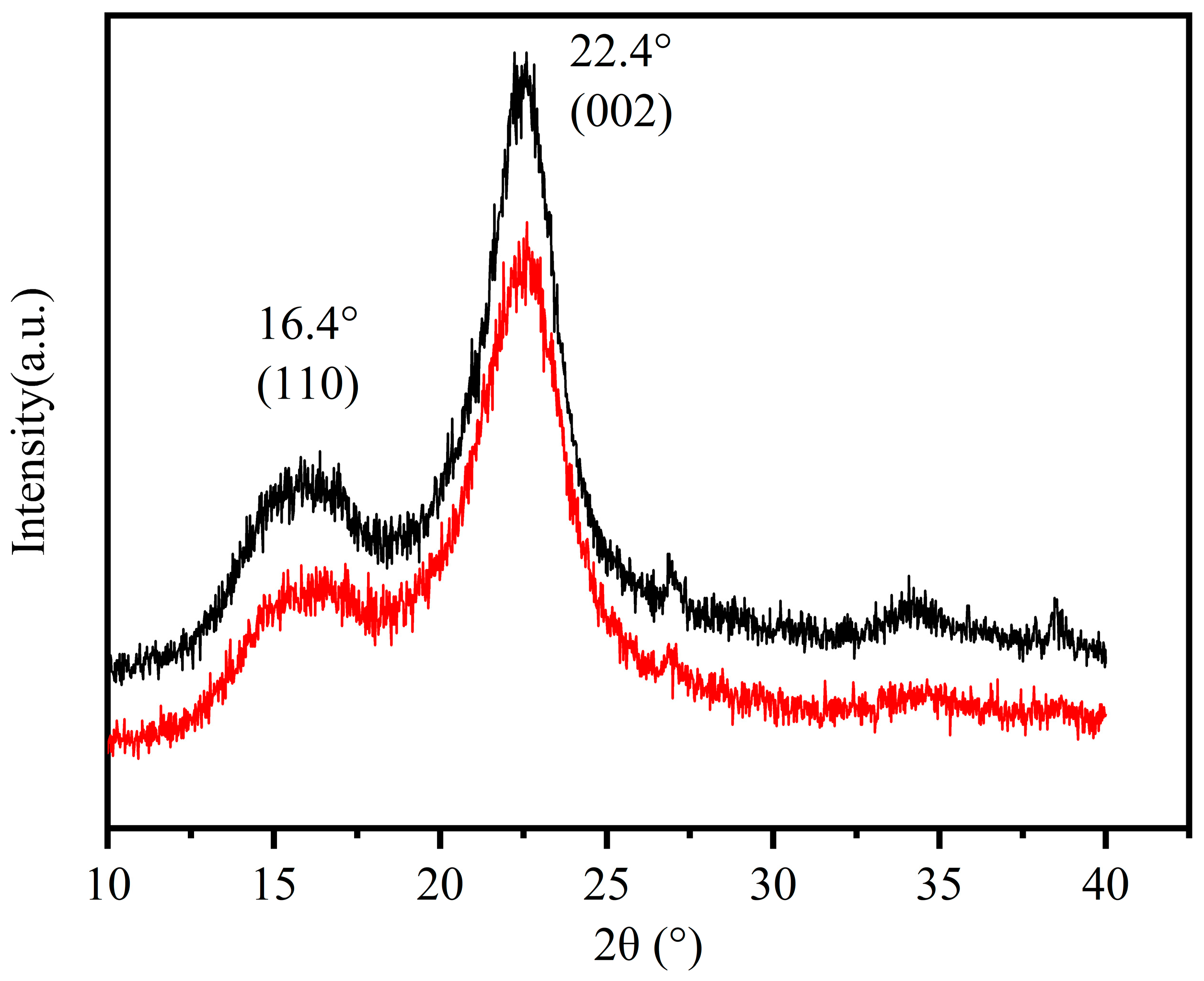


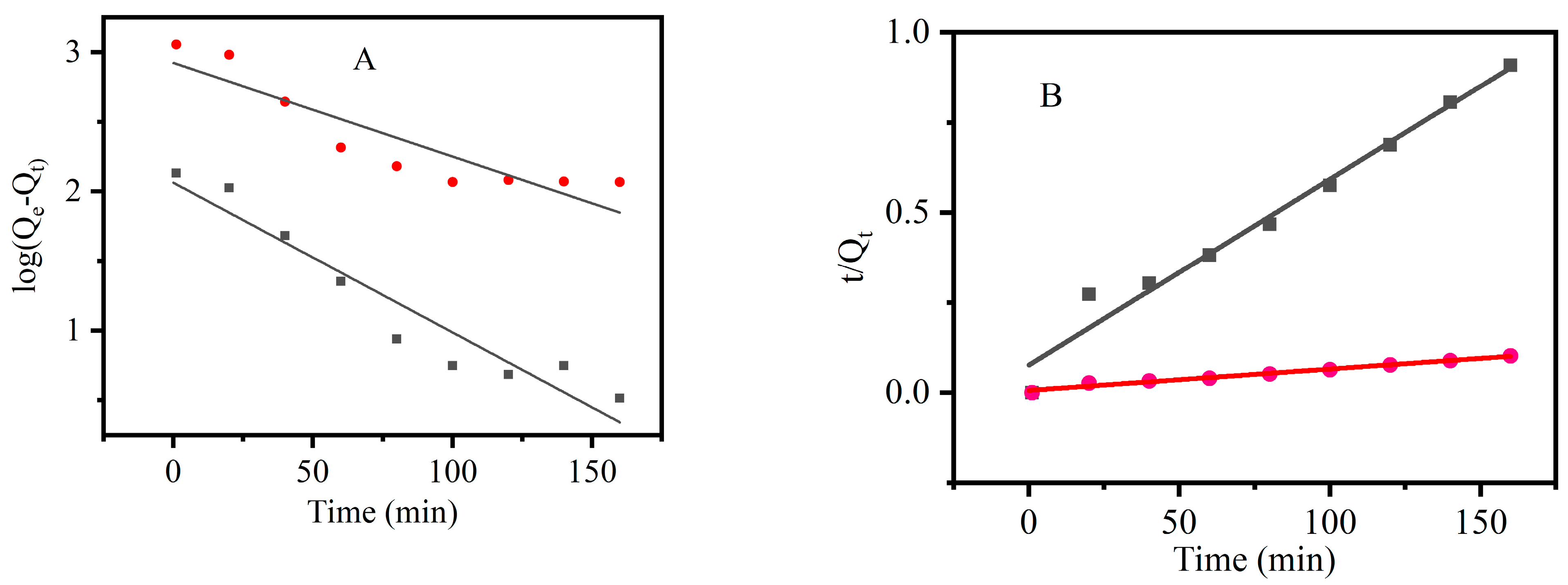
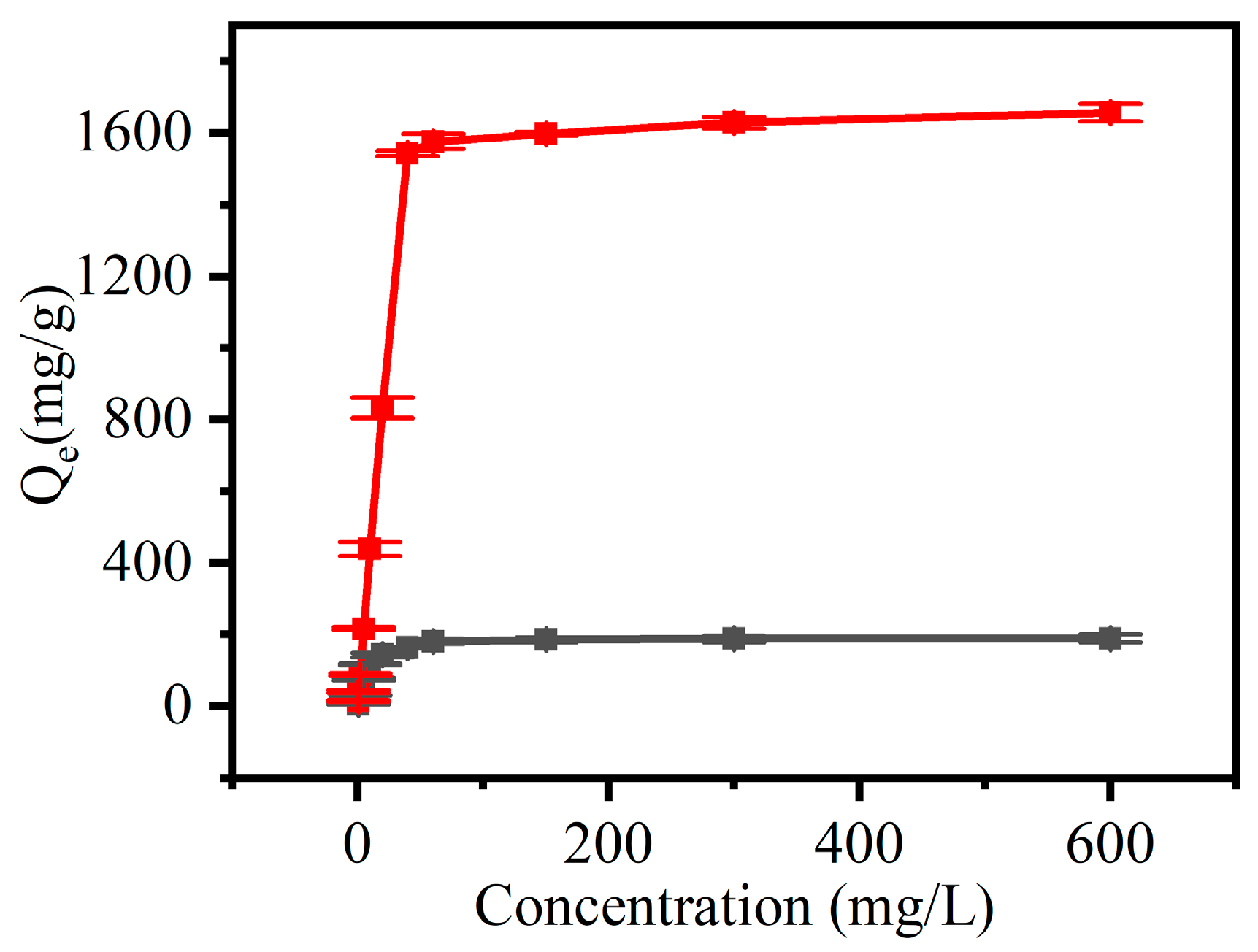
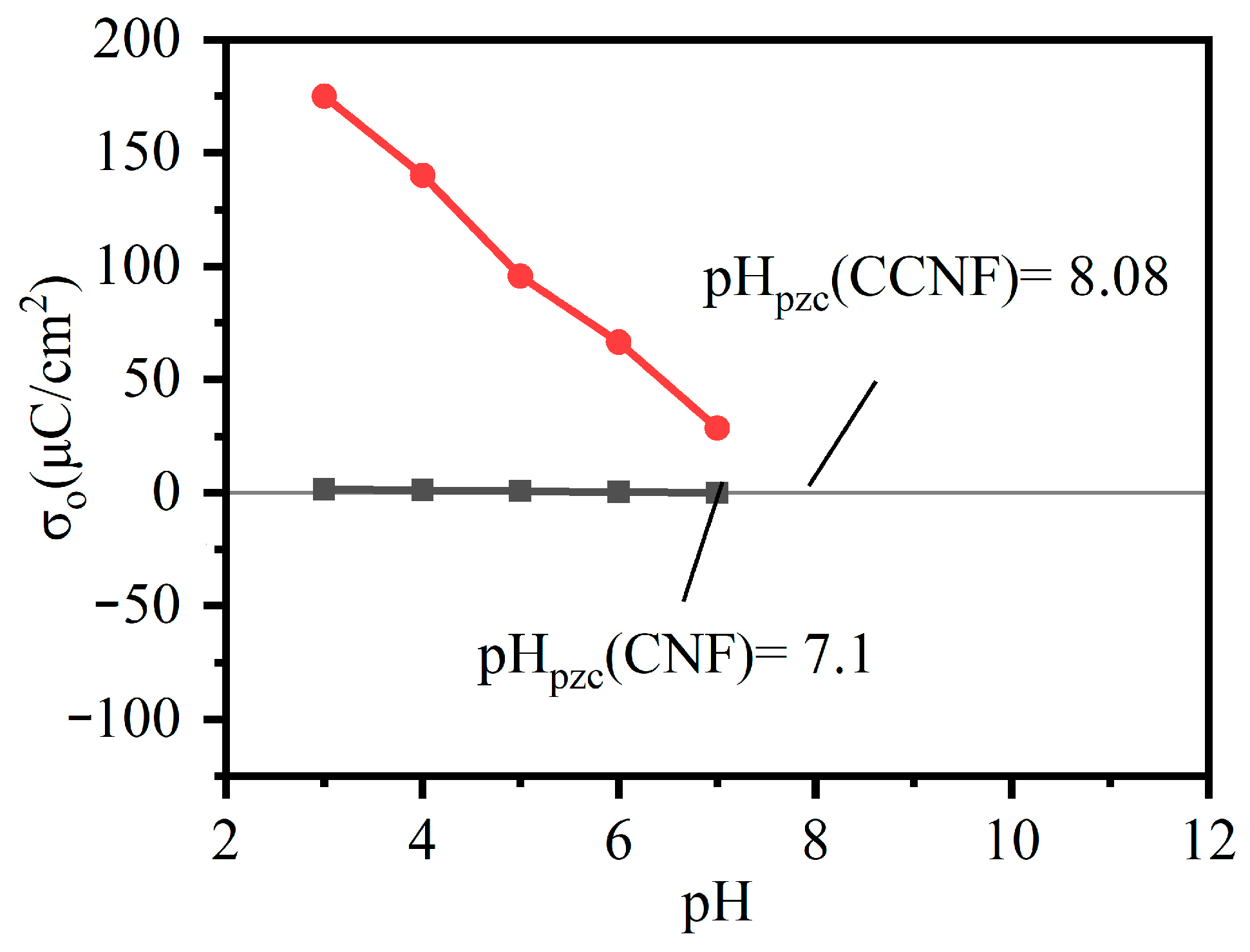
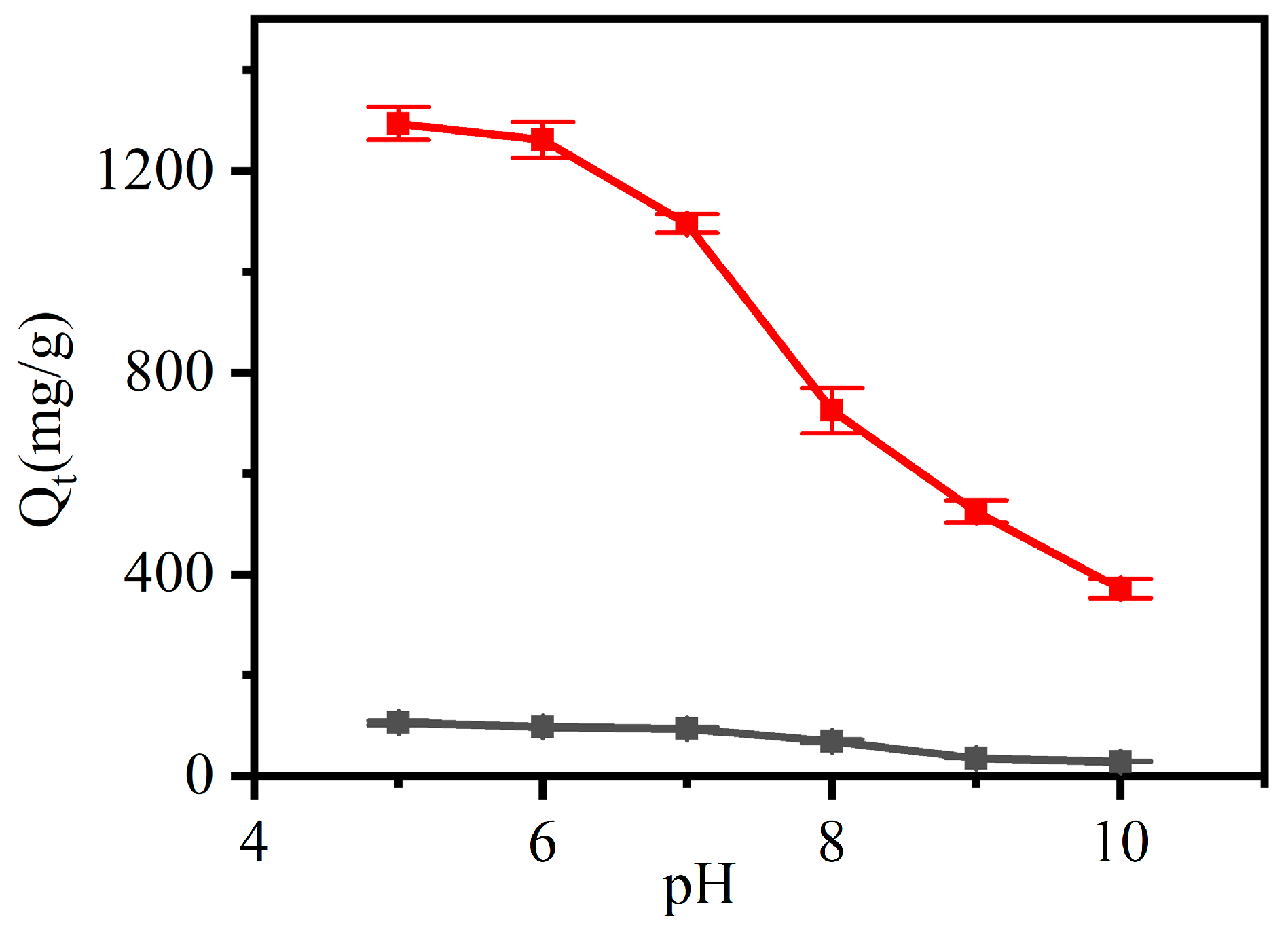
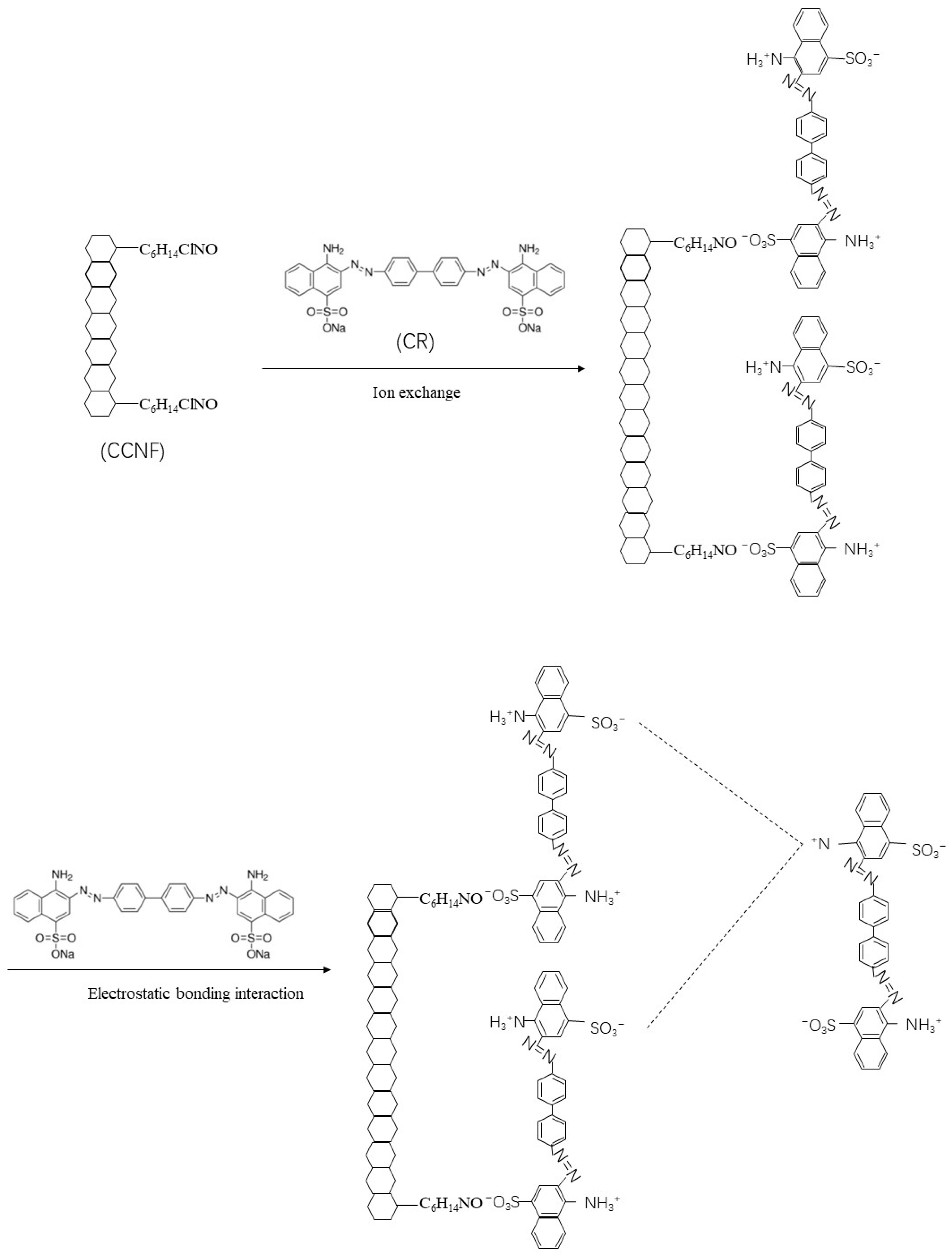

| Pseudo-First-Order Kinetics Model | Pseudo-Second-Order Kinetics Model | |||||
|---|---|---|---|---|---|---|
| Qe (mg/g) | K1 (min−1) | R12 | Qe (mg/g) | K2 (g/mg·min) | R22 | |
| CCNF | 836.97 | 0.01545 | 0.82491 | 1694.24 | 3.483 × 10–7 | 0.98068 |
| CNF | 115.82 | 0.02478 | 0.91921 | 193.80 | 3.337 × 10–4 | 0.97561 |
| Langmuir Isotherm Constants | Freundlich Isotherm Constants | |||||
|---|---|---|---|---|---|---|
| KL (mg/L) | Qm (mg/g) | R2 | P (mg/g) | N | R2 | |
| CNF | 0.08377 | 180.97 | 0.99926 | 25.19174 | 2.25 | 0.8192 |
| CCNF | 0.00803 | 1645.26 | 0.99543 | 135.30359 | 2.07 | 0.8609 |
Disclaimer/Publisher’s Note: The statements, opinions and data contained in all publications are solely those of the individual author(s) and contributor(s) and not of MDPI and/or the editor(s). MDPI and/or the editor(s) disclaim responsibility for any injury to people or property resulting from any ideas, methods, instructions or products referred to in the content. |
© 2023 by the authors. Licensee MDPI, Basel, Switzerland. This article is an open access article distributed under the terms and conditions of the Creative Commons Attribution (CC BY) license (https://creativecommons.org/licenses/by/4.0/).
Share and Cite
Zhang, L.; Huo, X.; Zhu, J.; Liu, C.; Wang, L. Residual Chlorella-Based Cellulose Nanofibers and Their Quaternization Modification and Efficient Anionic Dye Adsorption. Materials 2023, 16, 3642. https://doi.org/10.3390/ma16103642
Zhang L, Huo X, Zhu J, Liu C, Wang L. Residual Chlorella-Based Cellulose Nanofibers and Their Quaternization Modification and Efficient Anionic Dye Adsorption. Materials. 2023; 16(10):3642. https://doi.org/10.3390/ma16103642
Chicago/Turabian StyleZhang, Lina, Xiaomin Huo, Jin Zhu, Changbin Liu, and Lianfeng Wang. 2023. "Residual Chlorella-Based Cellulose Nanofibers and Their Quaternization Modification and Efficient Anionic Dye Adsorption" Materials 16, no. 10: 3642. https://doi.org/10.3390/ma16103642
APA StyleZhang, L., Huo, X., Zhu, J., Liu, C., & Wang, L. (2023). Residual Chlorella-Based Cellulose Nanofibers and Their Quaternization Modification and Efficient Anionic Dye Adsorption. Materials, 16(10), 3642. https://doi.org/10.3390/ma16103642








